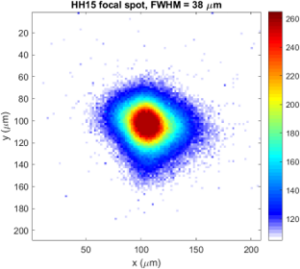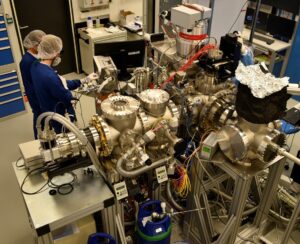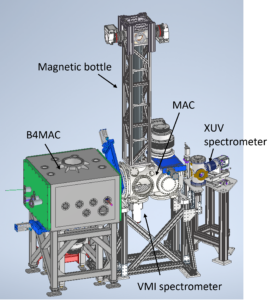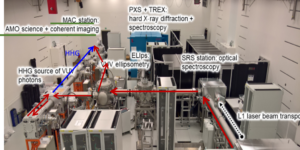MAC: Experimental station for AMO science and Coherent Diffractive Imaging
Staff:
Maria Krikunova
Eva Klimesova
Andreas Roos Hult
Ziaul Hoque
Martin Albrecht
Keshav Sishodia
Brief description of the available set up:
MAC chamber is located in E1 experimental hall (https://www.eli-beams.eu/facility/experimental-halls/e1-material-and-biomolecular-applications/ ) and is connected to the high-harmonic beamline (https://www.eli-beams.eu/facility/experimental-halls/e1-material-and-biomolecular-applications/hhg-beam-line/).
The design of MAC and available instruments is summarized in https://link.springer.com/article/10.1140/epjs/s11734-021-00192-z.
Update of the design is in https://doi.org/10.12693/APhysPolA.145.118.
Spectrometers and detection systems
At present the following spectrometers and detection systems are operational or in the commissioning pipeline:
- Electron and ion Time of Flight spectrometers (in house development)
- Velocity Map Imaging (VMI 75 mm MCP with a phosphor screen imaged by a camera with 166 fps 1936 x 1216 pix Sony CMOS 1/1.2″ sensor 72 dB (~ 12 bit resolution)) with ns gated imaging detector (Velocitas/Photec)
- Event-driven Tpx3Cam for VMI (https://www.amscins.com/tpx3cam/
- Simultaneous detection of time (ToA) and intensity in each individual pixel
- 256×256 pixel matrix, 55 µm pixel size
- Magnetic bottle electron spectrometer
- High collection and detection efficiency, high energy resolution
- Capability to perform electron – ion coincidence measurements
- Magnetic bottle electron spectrometer
- High collection and detection efficiency, high energy resolution
- Capability to perform electron – ion coincidence measurements
- XUV spectrometer
- PI MTE in-vacuum XUV camera
Sample delivery
At present the following sample delivery/handling systems are operational or in the commissioning pipeline:
- Fixed target stage
- Gas target – either needle source or a molecular beam (cryo-cooled Even Lavie nozzle).
- Cluster source
- For rare gas clusters with sizes from few nm to 100s nm
- Cryo-cooled valve for helium nanodroplet production
- Doping chamber with oven
Time-preserving monochromator:
4 sets of gratings covering the range (1) 10 to 28 eV, (2) 25 to 54 eV, (3) 51 to 98 eV and (4) 86 to 121 eV. Manually selectable exit apertures 50, 100, 200 and 300 mm.
HHG focusing
Ellipsoidal mirror with 1:4.8 imaging ratio. Focal spot verified in commissioning experiments: 40×40 um

Available NIR/HHG delay range
- Long delay line
- Maximum delay 6 ns (1 m length)
- Delay step < 3 fs
- Short delay line
- Maximum delay 600 ps (10 cm length)
- Delay step < 0.8 fs

MAC end-station with helium nanodroplet source

Model of MAC chamber with beam preparation chamber B4MAC and diagnostics: magnetic bottle, VMI spectrometer and XUV spectrometer

Schematic overview of the MAC chamber and B4MAC beam preparation chamber

MAC end-station in E1 experimental
Publications:
Update on MAC End-Station at ELI Beamlines Facility, E. Klimešová et al., Acta Physica Polonica A 145, 118 (2024), DOI: https://doi.org/10.12693/APhysPolA.145.118
Bright continuously-tunable VUV source for ultrafast spectroscopy, L. Jurkovičová et al., Commun. Phys. 7, 26 (2024), DOI: https://doi.org/10.1038/s42005-023-01513-5
Long-lasting XUV activation of helium nanodroplets for avalanche ionization, C Medina et al, New J. Phys. 25 (2023) 053030, DOI: https://doi.org/10.1088/1367-2630/acd5f6
Electron correlation dynamics in atomic Kr excited by XUV pulses and controlled by NIR laser pulses of variable intensity, A H Roos et al 2023 New J. Phys. 25 013038,
DOI: https://doi.org/10.1088/1367-2630/acb567
Nanoparticle-assisted acceleration of laser-irradiated low-density He ions, E Klimešová et al, Phys. Rev. A 104, L061101 (2012),
DOI: https://doi.org/10.1103/PhysRevA.104.L061101
A multipurpose end-station for atomic, molecular and optical sciences and coherent diffractive imaging at ELI beamlines, E Klimešová et al, Eur. Phys. J. Spec. Top. 230, 4183–4194 (2021),
DOI: https://doi.org/10.1140/epjs/s11734-021-00192-z
Plasma channel formation in NIR laser-irradiated carrier gas from an aerosol nanoparticle injector, E Klimešová et al, Sci. Rep. 9, 8851 (2019),
DOI: https://doi.org/10.1038/s41598-019-45120-3







